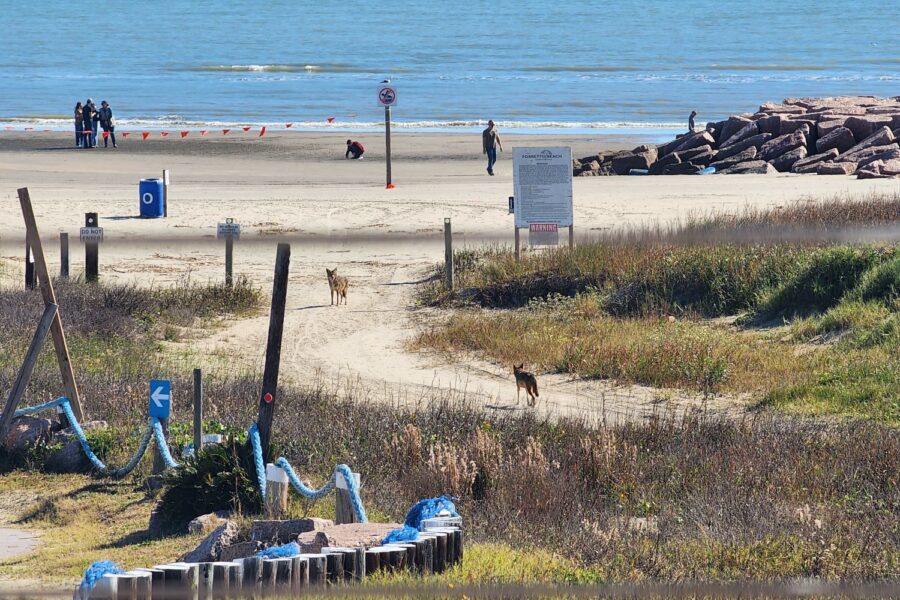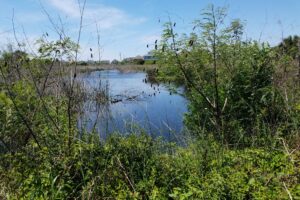As soon as I leave the car, I realize I must take a picture before walking another step toward our destination. The sky above Moody Gardens is enough to take my breath away. The palm trees and glass pyramid are too beautiful in concert not to preserve. I’m even amazed that we are here. A Town Hall Meeting is the last event I thought I’d ever attend during our two-month winter sojourn along the Texas Gulf Coast. Before the waning days of 2023, I had never even heard of Ghost Wolves.

Coyotes on Porretto Beach
It all started with brunch, or rather the time after our brunch that we spent exploring the grounds of Hotel Lucine. Eventually, we worked our way to their rooftop patio overlooking the sand and the sea across from Seawall Boulevard at Porretto Beach.
Along with everything you would expect a beach scene to be, there were a few interlopers. Coyotes. They were so fast I couldn’t tell if there were two, three, or four canids. I knew they lived in the East end, on and near the marshland leading to the ship channel. We saw and heard them in September when we were here. But the beach, the beach was a different story. I thought this was such a rare occurrence that I snapped a picture and posted it on my Facebook page and a Galveston-centric group’s Facebook page, Completely Galveston.
I grew up hearing howling coyotes on my grandmother’s farm late at night. For a farmer, coyotes were predators, a threat. Their cry was a warning to keep small animals safe from hungry wildlife. In the Texas Hill Country, they are shot and hung on fence posts. I always perceived them as creatures of the night that generally stayed away from people and populated areas. They were hunters who killed my Grandmother’s chickens while we slept. I didn’t consider them friends.
My photo/post hit a hot button for many of the readers of Completely Galveston’s Facebook page, and I didn’t have a clue why. At the time I had no idea that a new resort development was usurping the coyotes home, and that these canids were being evicted. Within days, there were over 1,700 reactions and 400+ comments. There were so many comments, comments on comments, and hundreds of reactions to numerous comments that I couldn’t keep track, much less read them all. Finally the groups administer had to suspend comments on the page, there were so many it was getting to be ridiculous. I wasn’t sure what I did wrong, but I seemed to be many individuals version of the Grim Reaper.
Facebook Comments


“Imagine a wild animal not being able to enjoy the perks of the planet because a few humans are scared. God forbid 2 play on the beach. It’s obvious that they are minding their own business. Why aren’t we?”
“The island is being overdeveloped with awful condos and too many homes. They’re losing their habitats. The ecosystem is being destroyed on our beautiful island. Makes me sick.
“This makes me sick! It is not the wildlife that is the problem. It is clearly the humans. All excited about animal control being in full force…Wow!!! This is their land, not ours. We are taking from them period!
A local Houston news station contacted me and asked if they could use the photo I posted – of course, I said yes. I learned the Galveston coyotes were rare – ghost wolves.
One individual commented with a photo of a Galveston Town Hall meeting poster to discuss what was going on with the local coyote population, aka Galveston’s Ghost Wolves. So here we are, waiting to learn.
Galveston Town Hall Meeting
The theater is huge and filling up fast. We all try to be considerate and give other parties space – at least a single seat between groups. This doesn’t last long as more and more people arrive. Someone uses a loudspeaker to ask all spectators to move to the middle and leave no seats empty. Finally, the theater is at capacity, and soon after, the program begins.

There are speakers here from around the country. Scientists from universities – Princeton and Michigan Tech. Individuals from the Galveston Bay Foundation, the Texas Conservation Alliance, a former Galveston resident who is now with the International Wildlife Coexistence Network, the Galveston Humane Society, and a photographer who first discovered that the Galveston coyotes were, well – different.
Ghost Wolves
The difference in the Coyotes that roam the beaches of Galveston is that many carry the DNA of the nearly extinct North Carolina red wolf. Thus, the Galveston coyote is also known as a ghost wolf. The red wolf still exists in small numbers today; bred in captivity, there is a concerted effort to reintroduce them into the wild.
It was not unusual for the red wolf (that migrated from NC to as far as Southern Louisiana and East Texas), under the right circumstances, to mate with coyotes. Thus, the coyotes/ghost wolves of Galveston offer a unique opportunity to the genetic keys of rebuilding populations of red wolves, which became extinct in the 1980s.
Three of these unique coyotes-ghost wolves of Galveston have been captured and tagged, and their movements followed. One is quite a traveler. And we see a slide of his – the yellow dot, green lines – movements. This canid has walked over 2,000 miles since being tagged, and according to his journey, he is amazingly fearless.

Another of the tagged ghost wolves spends most of his time in the wild area of Galveston State Park next to Jamaica Beach.
Questions and Answers
Individuals in the audience are concerned about many things. First, the unbridled development on the island that causes all the wild things to leave their natural habitat and venture onto the beaches and streets. There is concern for pets – are they in danger?
The answer to the first question is that they are working on it. Organizations are trying to buy up as much land as they can afford to keep the island partially wild. Meanwhile, they tell us, keep your pets inside, especially at night. The bottom line is what the experts worry about most is the extinction of the red wolf and preserving the DNA the Galveston ghost wolves carry.
There are many questions from the audience at the end of the talk. One is, “Why should we care?” There are many reasons.
Apparently, I have more to think about than which restaurant I want to visit and when the weather will be nice enough for another picnic at the beach. I sigh.
What the Conservationists Say
Restoring red wolves also enhances the Earth’s biodiversity. There are cultural and economic implications in restoring red wolves, as well, whether it is revering the wolf for its skills or what it represents in nature to the economic benefits of ecotourism or reducing crop damage caused by prey species.
Red Wolf Coalition
Red wolves play a vital role in regulating populations of deer, keeping them from over-browsing vegetation and farmland. Historically, red wolves also likely helped control raccoons and opossums, preventing these smaller predators from overpopulating to the point of endangering native songbirds.
Wildlands Network
If wolves went extinct, the food chain would crumble. The elk and deer population would increase (see chart on next slide) and eat the cow and other livestock’s food. Then we, the Humans, would have a food shortage in beef and dairy and possibly shortages in other food products too.
www.wsfcs.k12.nc.us
For more information on the Extinct Red Wolf, click the following links.
The Endangered Red Wolf Can Survive in the Wild
2015 – North Carolina Wants Feds to End Red Wolf Rewilding Program









Leave a Reply
Your email is safe with us.